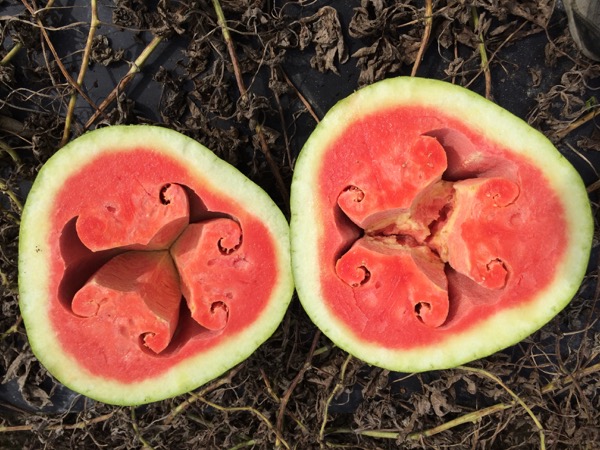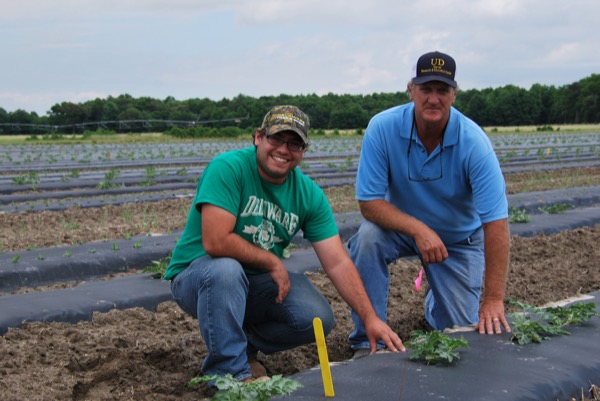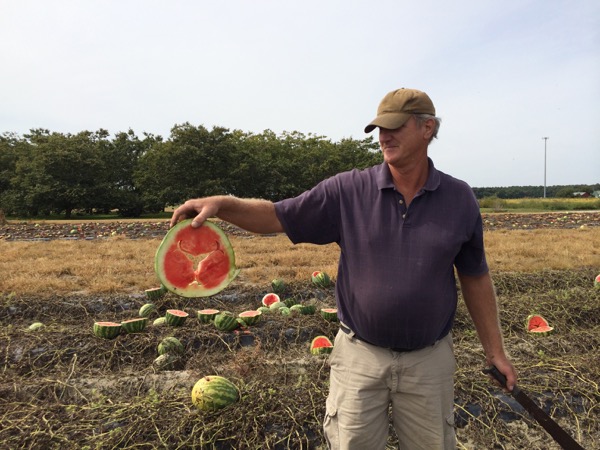Saving watermelons
UD researcher finds potential cause of hollow heart disorder in watermelons
10:06 a.m., June 18, 2015--Hollow heart disorder in watermelons affects growers throughout the United States and threatens the marketability of the fruit, which can lead to monetary losses.
Trying to find a cause and possible solution for the disorder, the University of Delaware’s Gordon Johnson performed a 2014 progressive pollinizer spacing study that showed that increasing the distance from a pollen source increased the incidence of hollow heart and reduced flesh density.
Research Stories
Chronic wounds
Prof. Heck's legacy
Johnson, a Cooperative Extension fruit and vegetables specialist and an assistant professor in the Department of Plant and Soil Sciences (PLSC), was assisted in the research by Donald Seifrit, a graduate student in UD’s College of Agriculture and Natural Resources.
A problem with hollow heart disorder is that it is difficult to predict when it will occur, which is frustrating for growers. “It’s not like a disease where you have a fungus or a bacteria or a nematode in the area,” Johnson explained. “It is something that occurs when it occurs, and doesn’t occur when it doesn’t occur.”
Because growers are unable to treat hollow heart through a pesticide or fertilizer application, they lack a defense to protect their crop.
Pollination study
Looking for a solution, Johnson turned to discussions by watermelon researchers that the disorder could be linked to pollination.
In 2010, he conducted a study in which he created situations to limit the pollen available to watermelons to quantify if that would have an effect.
“Basically, I designed a study where watermelons would be a longer or shorter distance from a pollen source,” said Johnson.
Johnson conducted the study on seedless watermelons – although hollow heart also occurs in seeded watermelons – because the bulk of the watermelon industry grows seedless varieties.
The production of seedless watermelons is a bit of a complicated system because the watermelon produces a seedless fruit but requires a pollinizer plant, which is the seeded type. Generally growers plant in a one-to-three ratio, with one seeded watermelon that produces viable pollen for every three seedless watermelons that do not produce viable pollen.
“You have to get the pollen transferred from the pollinizer to the seedless watermelon for fruit set,” Johnson said. “I set up some experiments to put seeded types at varying distances from the seedless, and I found that when you got further from a pollen source (wider ratio of pollinizer to seedless), you got more hollow heart.”
After the initial study, Johnson started repeating the experiments, continuing to put the pollen sources at varying distances or ratios. “Each time I would find that when I got further away (wider ratio), I would have a higher incidence of hollow heart,” he said.
Johnson also found that the flesh density of a watermelon variety plays a role in how it is affected by hollow heart. “When we looked at the more dense varieties versus the less dense varieties, the less dense varieties had more hollow heart, particularly when you moved away from a pollen source,” said Johnson.
To learn more about how density plays a role in watermelons affected by hollow heart, Johnson is looking at the initial number of cells that are being produced in the plant.
Johnson said that timing and weather conditions also have an impact on watermelons affected by hollow heart.
“It occurs in poor weather conditions, and oftentimes in the early watermelons,” he said. “That’s because we’re more likely to have cold nights or stormy conditions, particularly cold nights, where those early flowers are the most affected.”
Although it is rare to find hollow heart later in the year because growers generally have enough pollen being produced, Johnson said that if growers lose some pollinizers, or if the pollen producing watermelons don’t get planted, problems could still occur.
Industry buy-in
The relationship between hollow heart disorder and the amount of pollen that’s available has been accepted by the industry and Johnson is now able to make recommendations to growers about what factors might favor the disorder.
He points to three factors that could impact the frequency of hollow heart.
• The first is that the grower may not be getting enough pollen produced in the male flowers on the pollinizer plants.
• The second is the transfer of the pollen, which has to be moved from the , plants to the seedless plants by bees, may not be occurring at a high enough level.
• The third concerns whether the pollen being produced is actually viable.
“When I talk to growers, I address each one of those areas – the pollen production, the pollen viability and the pollen transfer – and tell them what they can do as far as management in each of those areas,” said Johnson, who has spoken in Florida, Georgia, Indiana, and Delmarva, the nation’s major Eastern watermelon growing regions.
“I’ve spoken at conferences and to growers and I even had a colleague who was able to repeat some of what I was doing last year. That’s always the telltale sign, when someone is repeating the study and getting similar results,” he said.
The presentations have reached more than 400 watermelon growers representing over 20,000 acres, and the recommendations have been well-received with over 91 percent of growers surveyed in seven states indicating that they would change one or more growing practices due to the research and recommendations presented.
Johnson said that one of the most interesting aspects of the study is that this isn’t his main research focus but more of a side project.
“It just goes to show that in all of the things that you do, you have got to be very observant and cannot be afraid to do side projects because oftentimes those projects are the things that become very important,” said Johnson. “I’ve talked to colleagues in the college and they always have a lot of different things going on, even if they’re not funded by grants. They’re trying different things because you never know where discovery is going to come from.”
Support for the research came from the MarDel Watermelon Association and a Specialty Crop Grant from the Delaware Department of Agriculture, funded through the U.S. Department of Agriculture.
Article by Adam Thomas
Photos courtesy of Gordon Johnson and by Jackie Arpie













